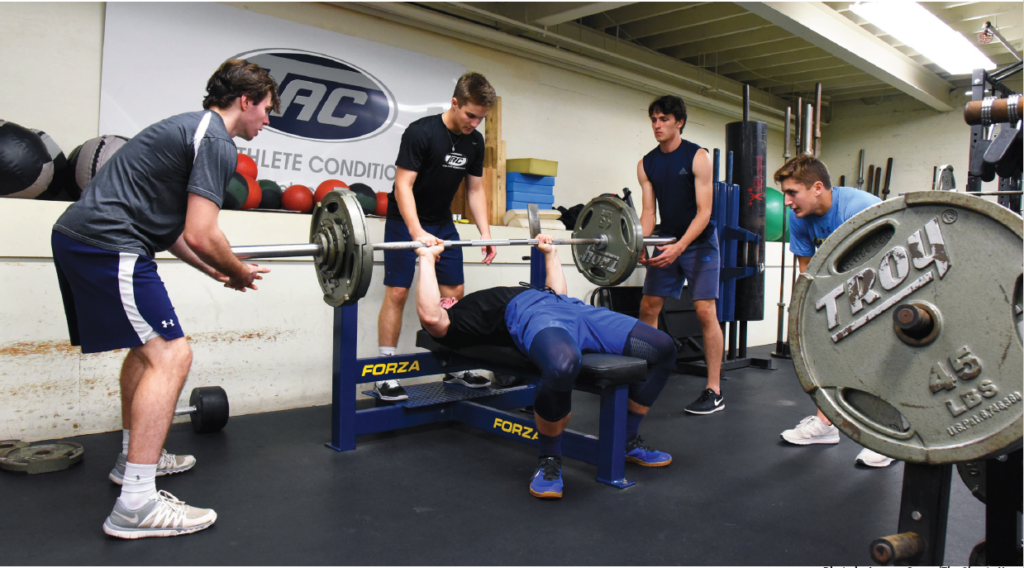
From left: Owen Collins ’19, Trent Schwab ’18, Chris Guyette ’19, Alex Tertyshny ’18, and Sam Silich ’19 in the weight room.
In 2004, Mr. Brian Holloway, the Head Trainer at Choate, founded Total Athlete Conditioning, or as it’s known colloquially, TAC. According to TAC’s website, the company’s goal is to “provide a world-class educational and training environment that is based upon current sport science methodology and hands on, practical experience,” as well as to “enhance all aspects of athleticism and human movement including: speed, power, strength, and agility.”
Because of its individualized and top-of-the-line training, TAC quickly became a popular option for highly-motivated athletes during their off-seasons. Many of the top athletes both at Choate and in the area began participating in the program, which had always just rented out the School’s facilities. Because of its growing popularity, a donor to the company wanted the program to become exclusive to Choate. In 2008, TAC started offering a program called Peak Performance which was exclusive to Choate athletes and took place during the school year.
Since then, Peak Performance has become an integral part of the Choate community for many top athletes. Mr. Holloway described the program at Choate specifically, “The athletes have to apply. We give priority to rising fifth and sixth formers, and those athletes who have their primary sport season upcoming get dibs. We’re a nine- to ten-week program depending on the term length. The requirement is that we train for two hours each session with four sessions a week. They also have two other sessions that are part of the program that help them enhance their recovery and their aerobic capacity and things of that nature. Those are always tweaked and geared toward an individual athlete’s needs as well as the requirements for their position. It’s a six day a week commitment.”
This individualized workout is one thing that has stood out most for Bella Deluca ’19.She said, “It’s really focused on breaking down the movements so that we get the correct form, so you don’t injure yourself. It really builds a base to build off— add weight, go faster, and push yourself farther.”
Jocelyn Polansky ’19, a player on the Choate Girls’ Varsity Basketball team, described the impact it’s had on her. “I feel more confident. I feel stronger overall, throughout my body. Going into a game, I feel really well prepared. I feel much more powerful,” she said. Deluca commented, “When I go play hockey on the weekends, it doesn’t feel like I haven’t been playing for the whole week. I get back to it, and I can just jump back in. It feels great.”
Trent Schwab ’18, a hockey and baseball player, is a three year Peak Performance and TAC veteran. He initially joined simply to help him “prepare for the hockey and baseball season with a heavy focus on lifting and diet.” He added, “I’ve done TAC for a couple years during both the summer and the school year, and I’ve seen the results that I’ve wanted.”
In terms of his performance on the ice and the diamond, Schwab said, “TAC has helped me to improve my speed, as well as my power, and I’m faster on the ice and on the field for having done it. I’ve also put on a good amount of muscle since I started, which has helped both my shot and my swing.”
Mr. Holloway added that’s the goal of the Peak Performance program. He said: “We are enhancing the physical qualities that allow an athlete to maximize their potential. It is not just a weight program; we have to incorporate everything from the sport’s technique to enhance that, as well as the bio motor output. That’s your speed, your strength, your power, which most people think of when their doing offseason training. The other components are sensorimotor: their game sense or awareness, as well as their ability to utilize some of their physical qualities more effectively when they get on the field, ice, or court.”
Mr. Holloway also made sure to mention the mental aspect of TAC. “The psychological component is huge too. All of these things need to be accounted for and addressed, and what that comes out to be, when done well, is a high-performance model. Ultimately, that’s our goal: to create a high-performance model for our athletes.”



